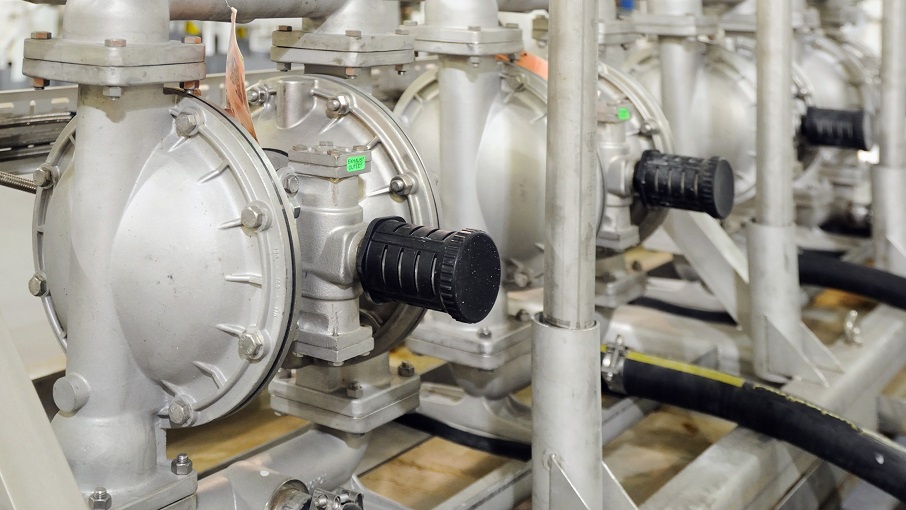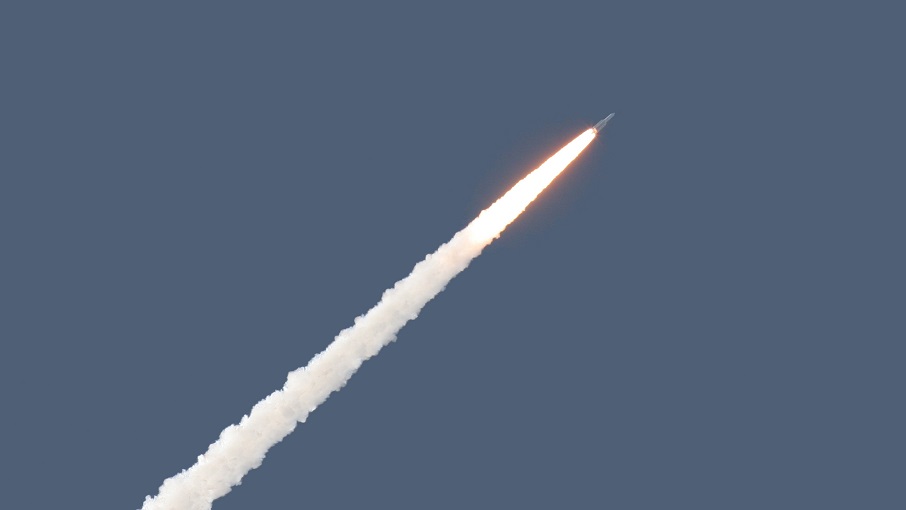

There has been significant growth in pumps that employ diaphragms as many industries recognise the contribution these pumps can make to process engineering. Here, we examine how flexible barrier materials for diaphragms can solve challenges faced by AODD and dosing/metering pumps.
Air-operated double diaphragm (AODD) and dosing/metering pumps are two very different types of positive displacement pumps, but what they have in common is the use of diaphragms. Whereas the AODD pump is generally used for the transfer of higher volume liquids, the dosing/metering pump has its niche in the continuous in-phase metering of single or multiple liquid systems at varying flow rates.
The growth in demand for mechanically coupled and hydraulically actuated diaphragm pump heads can largely be attributed to the development of materials suitable for diaphragms. Thermoplastic elastomers (TPE) and Polytetrafluoroethylene (PTFE) synthetic materials used in the manufacture of diaphragms have opened up new opportunities for AODD and dosing/metering pumps. For both pump types it is essential that the diaphragm material is compatible with the fluid being pumped and that it is flexible at low temperatures and does not deteriorate at high temperatures and pressures.
AODD pump diaphragms Over the past half century, the AODD pump has evolved to become a proven technology for the complex fluid transfer needs encountered across many industries. The pump’s reputation is built on the technology’s ability to handle a wide range of liquids with varying characteristics. With the AODD pump it doesn’t matter if the fluid is thick, thin, particle-free or in the form of slurry. The pump’s design allows it to pull in the liquid, regardless of its composition, and drive it downstream.
The importance of the diaphragms in an AODD pump cannot be over-estimated; if they fail, then so does the pump. Using compressed air to act upon the diaphragms, the liquid media is pulled into the pumping chamber and then ejected, without the use of rotating parts. When running, the only dynamic components that come into contact with the fluid are the two diaphragms which are connected by a common shaft, the two inlet valve balls and the two discharge valve balls.
The diaphragms act as a separation membrane between the compressed air supply and the fluid. Driving the diaphragms with compressed air balances the load on the diaphragm, thereby removing mechanical stress and extending diaphragm life. The valve balls open and close on the valve seats to direct the flow.
The AODD pump can be used at every stage of the liquid transfer production cycle, from off-loading raw ingredients from tankers to transporting semi-processed and processed product around the plant. The pump offers the ability to handle shear-sensitive fluids, keep thick and viscous fluids constantly flowing and provide leak-free operation.
Material selection Correct diaphragm material selection is critical to ensure safe pump operation. The primary factors to consider when choosing diaphragm materials are chemical compatibility, temperature range, abrasion resistance, flex-life, performance, sanitary standards, resistance to cleaning fluids, particle build-up on the diaphragm surface, suction lift, efficient performance and cost. To help meet these diverse operational criteria, the number of effective diaphragm materials has grown.
Diaphragms are the hardest worked components in an AODD pump and can be expected to work for up to 10,000 hours before needing to be replaced. It’s a tough call because the desired flexibility of the diaphragms has to be maintained throughout their operating life in order for the pump to operate effectively on start-up.
Achieving maximum mean time between failures (MTBF) must be a priority in selecting a diaphragm, which means matching the diaphragm materials to the fluid being pumped and the pump’s operating conditions. Materials that offer a long flex-life provide predictable performance, enabling planned maintenance and membrane replacement. In many situations AODD and also dosing/metering pumps are open to the elements, so the diaphragms must be able to withstand extreme temperatures.
Diaphragms challenges Both AODD and dosing/metering pumps can be found operating in a diverse range of industries and each industry will pose its own set of challenges. That said, regardless of the industry they all have common requirements that must be met. Operators need their pumps to be in a state of readiness when called upon during the production cycle and to provide smooth, leak-free, and accurate pumping, coupled with low maintenance. If these basic requirements are not met, then there will be the inevitable adverse impact on the efficiency of the production line.
Pump downtime, loss of product, product contamination and frequent replacement of components, all result in high running costs and lifetime cost of ownership. These issues often lead to production delays, dissatisfied or lost customers, reduced capacity and impact the bottom line.
The challenges posed by industries such as foodstuffs, pharmaceuticals and personal care products can differ considerably from those in wastewater, paints and coatings, and chemicals. Surfaces must be compatible with all relevant industry standards, ultra-smooth to ensure a smooth flow, crevice-free to avoid any solids becoming trapped, not prone to cracking and be suitable for liquids used in clean-in-place procedures. Any break-up of the diaphragm surface has the potential for cross-contamination of the pumped media. Where foodstuffs are being pumped, the possibility of the media shearing or splitting and its potential to adhere to the diaphragm surface will always be considerations.
In chemical processing and where aggressive or hazardous materials are involved, the pumped media can be of a very low lubricity and therefore abrasive. These problems will challenge the perm- eability of the surface and result in potentially harmful vapours or volatile organic compounds damaging pump components and leaking to the atmosphere.
Saint-Gobain Given the extensive list of factors that will influence the performance of diaphragms, it is easy to come to the conclusion that it is a problem which many industries have to accept. However, that’s not the case. Significant advances in the development and refinement of existing materials mean that pump users can overcome the challenges set out above and achieve efficient production that improve operational efficiencies and the bottom-line profit.
Saint-Gobain Films & Fabrics has been at the forefront of the development of flexible barriers for diaphragms that have been shown to challenge and solve the issues discussed. In certain applications, increases in flex cycles and lifetime have been up to 70% higher than regular modified PTFE and vapours’ permeability was reduced by 30%.
“In developing our flexible barrier materials, Saint-Gobain Films & Fabrics have concentrated on the issues that impair diaphragm performance, the results being products that increase MTBF, improve productivity and extend pump working life through greater reliability,” explains Frank Sonnenschein, Business Development Europe.
“Compliance to all relevant international standards has been a priority in the development of Flex Barriers and developing the range of industries served. Our Flex Barriers have practically universal resistance to chemicals and highly aggressive media such as aromatic or chlorinated hydrocarbons, acids, caustics, ketones and acetates.”
Flex Barriers Resins used to produce Saint-Gobain’s Flex Barriers conform to the major regulations critical to success in pharmaceutical, food and beverage, sanitary and medical applications. These include: FDA21 CFR177.1550, (EC) No.1935/2004, (EU) No.10/2011, (EC) No.23/2006 (GMP), USP Class VI and 3-A Sanitary Standard. In addition, the materials conform to REACH (EC) No.1907/2006 and RoHS (2011/65/EU) regulations, so they do not contain any hazardous or banned comp-ounds that would restrict the materials used in products.
Available in different constructions, as single layer film or laminated composites, Flex Barriers are based on high quality raw materials. Saint-Gobain Films & Fabrics uses specialised surface treatments and a proprietary process to impart high flex life, low permeability, high smoothness and a low coefficient of friction in its Flex Barriers. The resulting products can be thermoformed by customers to produce a diaphragm to their required size.
The sodium ammonia etched barrier film can be bonded to the customer’s carrier diaphragm (typically rubber) and from there thermoformed and vulcanised, usually in a single operation. Alternatively, the PTFE barrier can be pre-formed prior to vulcanization. The Flex Barriers are available to pump diaphragm manufacturers in rolls or sheets suitable for stand-alone diaph-ragm components. With special surface treatment, the films are designed for high-integrity bonding to rubber-backed diaphragms.
Problems solved PTFE rupture, a major cause of diaphragm premature failure, has been solved by the exceptional flex-life performance of Saint-Gobain’s Flex Barriers. “An often under-appreciated benefit of these Flex Barriers is their gradual mode of failure as opposed to catastrophic, which means the sites have a chance to organise maintenance/ replacement in a planned manner rather than having to deal with a sudden “line shutdown” and material losses,” explains Frank Sonnenschein. Furthermore, diaphragm delamination resulting from poor and in-consistent bonding of PTFE and rubber as well as damaging media permeation has been eliminated. The result is excellent durability with a significantly reduced stretch void index.
Contamination attributable to a diaphragm’s rough surface has been eliminated by the smooth inert surface of the barrier. In addition, for deep drawing manufacturing issues, where the problem’s root cause is stiff and heterogeneous material, the high quality and flexibility of these barrier films removes causes for concern.
Application success Diaphragm manufacturer Gottlob Dietz has benefitted from using Saint-Gobain Flex Barriers, having managed to further increase diaphragm reliability and lifetime for its global customers. In order to decrease the risk of failures resulting from disc rupture and delamination between PTFE and rubber backing on pharmaceutical dosing pumps, Gottlob Dietz switched to the new Flex Barriers. It increased the flexibility and lifetime, demonstrated improved resistance to permeability and greater bonding strength with the rubber backing.
Diaphragm rupturing during thermoforming, chemical resistance to rocket fuels and permeation were problems that the Ariane Group encountered in its Ariane 5 space programme. “These problems affected the entire programme not only due to costs but mainly to safety reasons,” explains Frank Sonnenschein. “Working together, we solved these problems through the co-development of a multi-layer fluoropolymer laminate solution.”
Using this product Ariane resolved the safety issue, enabling the rocket to enter space with a more effective fuelling system. Through this cooperation Saint-Gobain Films & Fabrics has established that higher levels of formability than ever imagined are now possible. Furthermore, the mechanical robustness of these materials opens the door to even substituting steel diaphragms to reduce pump size and costs.
For further information, please contact: Frank Sonnenschein, Business Development manager, Saint-Gobain Films & FabricsFrank.Sonnenschein@saint-gobain.com Tel: +49 (1525) 7438915






